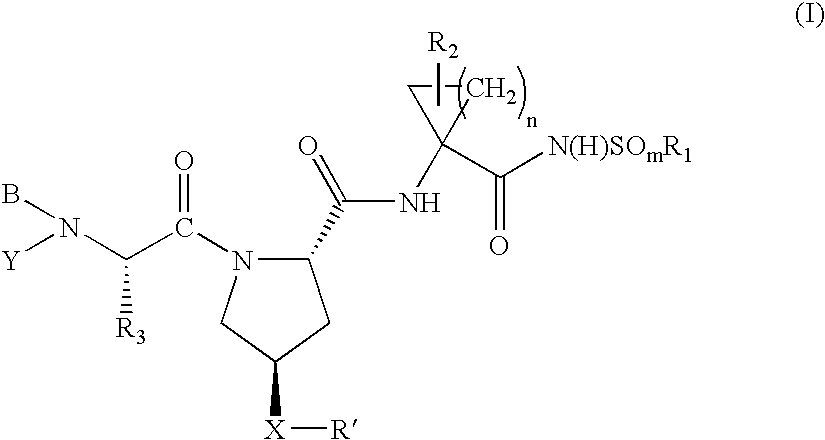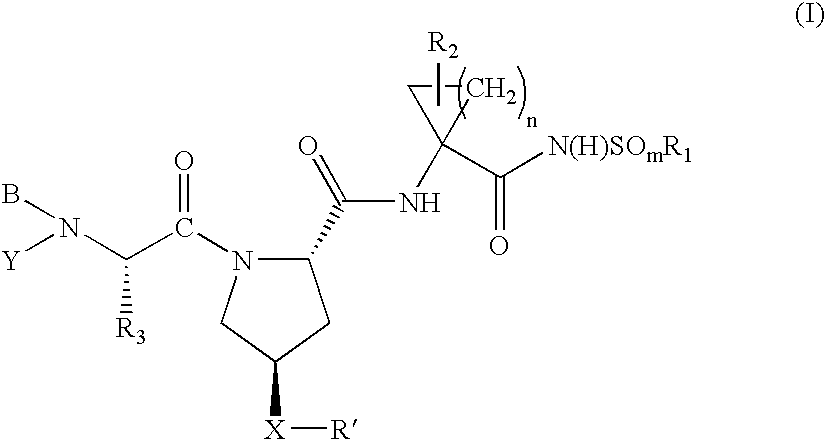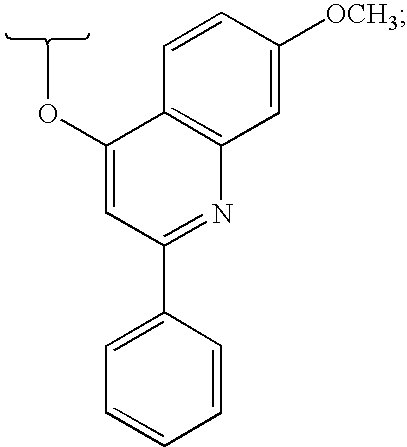Hepatitis C virus inhibitors
- Summary
- Abstract
- Description
- Claims
- Application Information
AI Technical Summary
Benefits of technology
Problems solved by technology
Method used
Image
Examples
example 1
Preparation of Compound 1
[0256]
Step 1:
[0257]A mixture of 3,5-dimethyl-4-nitro-isoxazole (1.42 g, 10.0 mmol), phenylacetaldehyde (1.32 g, 11.0 mmol) in piperidine (1 mL) and ethanol (10 mL) was heated to reflux for, 16 h. After cooling down to the ambient temperature, the product precipitated out was collected by filtration. The cake was washed with cold ethanol thoroughly to afford 1.20 g (53%) of the desired product as a white solid.
[0258]1H NMR (CDCl3) δ 2.87 (s, 3H), 7.46-7.50 (m, 3H), 7.56 (d, J=8.5 Hz, 1H), 7.7-7.80 (m, 2H);
[0259]LC-MS (retention time: 1.19 min, method B), MS m / z 227 (M++H).
Step 2:
[0260]A solution of 3-methyl-5-phenyl-isoxazolo[4,5-b]pyridine 4-oxide (1.00 g, 4.40 mmol) and POCl3 (2.71 g, 17.7 mmol) in chloroform (10 mL) was heated to reflux for 1 h. After cooling down to the ambient temperature, the final solution was diluted with chloroform (50 mL) and washed with NaHCO3 (aq.) (two 50 mL portions) and brine, dried over MgSO4, filtered, evaporated. The residue...
example 2
Preparation of Compound 2
[0285]
Step 1:
[0286]A mixture of 2-amino-6-methylpyridine (1.08 g, 10.0 mmol), ethyl benzoylacetate (2.30 g, 12.0 mmol) and polyphosphoric acid (6.00 g, 61.2 mmol) was heated to 110° C. for 5 h. After cooling to the ambient temperature, the mixture was poured into iced water (20 mL) and neutralized to pH 7 with 10 M NaOH. Extracted with CHCl3. The organic layer was washed with brine, dried over MgSO4, filtered, evaporated. The residue was purified by flash chromatography (1:1 hexane-EtOAc) to afford 510 mg (22%) of the desired product as a pale yellow solid.
[0287]1H NMR (CDCl3) δ 3.08 (s, 3H), 6.64 (d, J=7.0 Hz, 1H), 6.71 (s, 1H), 7.42-7.52 (m, 5H), 8.04-8.06 (m, 2H);
[0288]LC-MS (retention time: 1.21 min, method B), MS m / z 237 (M++H).
Step 2:
[0289]A solution of 6-methyl-2-phenyl-pyrido[1,2a]pyrimidin-4-one (489 mg, 2.07 mmol) in melted diphenyl ether (5 mL) was heated to gentle reflux for 5 h. After cooling to the ambient temperature, the formed suspension was...
example 3
Preparation of Compound 3
[0299]
Step 1:
[0300]To a solution of 4-methoxyphenethyl alcohol (1.52 g, 10.0 mmol) in CH2Cl2 (50 mL) at 0° C. was added Dess-Martin reagent (4.45 g, 10.5 mmol) in one portion. The formed mixture was allowed to warm to the ambient temperature for 1 h. Washed with sat. Na2S2O3 (aq) and 1M NaOH, brine respectively. Dried over MgSO4, evaporated in vacuo to give 1.50 g (100%) of the desired aldehyde as a viscous oil. This product was used as crude without any further purification.
Step 2:
[0301]A solution of 3,5-dimethyl-4-nitro-isoxazole (142 mg, 1.0 mmol), 4-methoxyphenylacetaldehyde from Example 3, Step 1 (180 mg, 1.1 mmol) in piperidine (0.1 mL) and ethanol (2 mL) was heated to reflux for 12 h. After cooling down to the ambient temperature, the product precipitated out was collected by filtration. The cake was washed with cold ethanol thoroughly to afford 130 mg (51%) of the desired product as a grayish solid.
[0302]1H NMR (CDCl3) δ 2.88 (s, 3H), 3.87 (s, 3H), 7...
PUM
| Property | Measurement | Unit |
|---|---|---|
| Fraction | aaaaa | aaaaa |
| Fraction | aaaaa | aaaaa |
| Fraction | aaaaa | aaaaa |
Abstract
Description
Claims
Application Information
 Login to View More
Login to View More - R&D
- Intellectual Property
- Life Sciences
- Materials
- Tech Scout
- Unparalleled Data Quality
- Higher Quality Content
- 60% Fewer Hallucinations
Browse by: Latest US Patents, China's latest patents, Technical Efficacy Thesaurus, Application Domain, Technology Topic, Popular Technical Reports.
© 2025 PatSnap. All rights reserved.Legal|Privacy policy|Modern Slavery Act Transparency Statement|Sitemap|About US| Contact US: help@patsnap.com



